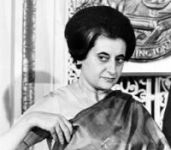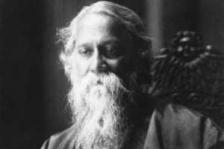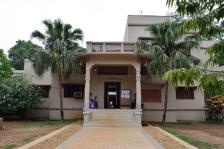
Eminent director and our member, Mr Shyamal Sengupta, narrates an amusing episode during his stint as an interior decorator, to Mousumi Gupta.
...
Eminent director and our member, Mr Shyamal Sengupta, narrates an amusing episode during his stint as an interior decorator, to Mousumi Gupta.
Years ago, Mr Sengupta got the opportunity of a lifetime to decorate then Prime Minister Mrs Indira Gandhi’s room in Delhi.
He obviously felt honoured and humbled as he carried out the interior decoration whole-heartedly. It was highly appreciated by Mrs Gandhi. He came back satisfied to Kolkata, then Calcutta, after completing his assignment.
“However, soon after I landed in Calcutta, I got a telephone call from Mrs Gandhi’s secretary saying that a key element was missing in the décor. To my utter surprise, I was then told that I had missed out arranging for a mosquito net in the PM’s room,” said Mr Sengupta.
“I actually didn’t know that I was supposed to arrange for a mosquito net. So what followed next was the specification—it had to be cotton, pink in colour and that too must be complemented with pink frills and delivered to her residence the next day. How could I ignore the Prime Minister’s request!?” reminisced Mr Sengupta.
Mr Sengupta directly went to a popular mosquito net market in south Kolkata’s Chetla Haat. After looking around in several shops, he arrived at the conclusion that mosquito nets of various categories and specifications were available but all in white colour. “But the PM’s choice was pink! So, I asked one of the shop owners to buy Ranjak soap (used to dye clothes in those days) and colour the white mosquito net into pink,” said Mr Sengupta.
“The shopkeeper agreed, but nature played spoilsport. It was monsoon. And it kept raining intermittently. So, the big question was how to dry the mosquito net overnight,” recalled Mr Sengupta.
He then asked the shop owner to arrange for six big chulhas (portable clay ovens) to help dry up the mosquito net. The whole night, the net was hung up after dyeing in the heat generated by the burning clay ovens.
The precious pink mosquito net was parceled by a flight to Delhi the next morning before it could be handed over to the staff of its rightful owner.
“The hullabaloo over the simple pink mosquito net will forever be etched in my mind,” said a smiling Mr Sengupta.
Want to share your experience? Please mail your story to writetous@supportelders.com with your name

One of our members, Sujoy Roy, writes on how Rabindranath Tagore went on a lecture tour to the USA in 1916 and nearly fell into a crossfire ...
One of our members, Sujoy Roy, writes on how Rabindranath Tagore went on a lecture tour to the USA in 1916 and nearly fell into a crossfire of political assassination and American official counter-intelligence.
James B. Pond was Tagore’s tour agent. Pond wrote to Macmillan, the publishers, that “Tagore’s tour could be made one of the biggest lecture tours.” However, half-way through the tour, the Minneapolis Tribune called the poet “the best businessman who ever came to us out of India”. He managed to scold Americans “$700 per scold” and “$700 dollars per plead”. What was meant was that Tagore did not miss out on manifest frowning down on America’s penchant for gross materialism and narrow nationalism; while in the same breath, he was earning every dollar for his school in Santiniketan. This ambivalence was seemingly verging on hypocrisy and was to prove dangerous quite soon.
Back in 1912-13, he had visited the Bay Area on the West Coast with some huge success, making him a cult figure. He had taken San Francisco’s intellectual elites by storm. Now came a fomenting danger from Indian revolutionaries living in the Bay Area, who despite being appreciative of his intellectual prowess, considered Tagore to be standing aloof of anti-imperialist revolutionary movement. They considered the heart of India was in the anti-British revolutionary movement.
A near parallel underlined the minds of Indian youths to Goethe’s non-committal attitude towards Germany’s war of liberation a century ago. A plot to assassinate him was hatched. Two Indian youths were despatched to Tagore’s hotel to do a hatchet job, but the youths chickened out. The American administration got the scent of it and spirited him away to Santa Barbara with police protection.
The newspapers headlined “Hindu Savant Safe After Wild Flight Under Body Guard”. Tagore gave no credence to the approaching political storm over him. He spent a day relaxed, sitting on the beach under the fragrant groves of orange trees. To a reporter he declared about Californian women “It was a pleasure simply to watch them”.
Tagore mooted for the first time the nucleus of his vision of founding Visva-Bharati in Santiniketan as a web of world culture and wrote to his son, Rathindranath, accordingly. This should strike us as a quirky utopia which dawned on him in southern California, in the vicinity of Hollywood—and just a few days after some of his own countrymen anti-British revolutionaries thought of eliminating him. The place was a land of hedonistic culture where gross materialism and instant gratification were the holy grail.
But for the poet, there were hassles. The poet was living out of briefcase, as it were from trains and hotels through a roving lecture tour. He preferred eating quietly alone in his room with Boston Baked Beans, thereby going weak with vegetarian regimen trying to save money for Santiniketan. Perhaps, the food gave him a gaseous estimation of himself.
One early morning, he woke up Pearson on the train telling him that he had tipped his set of teeth down the lavatory basin, where he had kept them on the night before. Fortunately, his dentist at Yokohama had made him a denture which suited him better for public speaking. To add to the troubles, his wardrobe became dispersed. The enraged man had to give a lecture in a silk shirt and tweed trousers providing a hilarious amusement to spectators.
The New York Times commented after reviewing his 10 volumes of work in December that Tagore’s was a lone voice above clamour of nations and their aggrandizement. But the press was divided. He was also regarded as a vaporously philanthrophic thinker like Whitman and others. Now, war clouds were in the air. His views on humanitarian world unity would have to go through wrecking trials in two world wars. He had a dream of bridging an east-west unity between men and matters. But the west itself was divided between imperialist nations going at each other’s throat.
He terminated his tour in America in 1916. "Ich bin mude (I am tired)," he said to his friend Harriet Moody in America.
Postscript
At one time, Rabindranath was once lodged in a grand log-house known as Yama Farms in Catskill Mountains north of New York City. This was a kind of retreat, where outstanding industrialists and intellects like Thomas Alva Edison, Henry Ford, Harvey Firestone, Waterman of fountain pen fame, Mr Colgate and the Kodak among others stayed in close proximity. As the story goes, Tagore was being sketched by two Russian artists in a house on the estate.
Rabindranath pulled out a dime from his pocket saying: “Isn’t it odd that an old gentleman gave me this when he was waiting for his car. Do I look like a tramp?” That evening, the owner of Yama Farms identified the donor as Rockefeller, who had mentioned giving a dime to “an old Negro”.
Pic credit: https://upload.wikimedia.org/wikipedia/commons/1/1a/Rabindranath_Tagore.jpg
Want to share your experience? Please mail your story to writetous@supportelders.com with your name

One of our members, Ms Sukla Gupta, describes to Mousumi Gupta how the values her upbringing in Tagore’s abode, Santiniketan, imbibed in her helped her cope with the challenges ...
One of our members, Ms Sukla Gupta, describes to Mousumi Gupta how the values her upbringing in Tagore’s abode, Santiniketan, imbibed in her helped her cope with the challenges in life.
Ms Sukla Gupta was brought up in Santiniketan, in fact, in Sriniketan in the 1930s and 1940s.
“My father was first posted there with the agricultural development authority in 1932. But for some reason, he left the place and went on to work in some other city. He came back to Santiniketan in 1936 on a call from Rabindranath Tagore, who wanted him to develop the area,” said Ms Gupta. It was from then that the family started to live in Sriniketan, the twin city of Santiniketan.
“The area at that time was almost barren with very less rainfall and agriculture. The place started to develop during his time,” recalls the lady. She was taught in a co-education school in Sriniketan, and the interesting part of that school was all the teachers were women, her mother was also associated with that school.
“The school was till Class VI after which she was shifted to Santiniketan, where she came in contact with several well-known personalities as either teacher or schoolmate. One such big name, Amartya Sen, was two classes senior to me. The way they studied was typical Santiniketan style, classes under the trees, going barefoot, sitting on mats and moreover, no punishment in class and evaluation through grading. The unique part is the students used to shift from one place to another for their classes and not the teachers,” said Ms Gupta.
According to Tagore, children can’t sit at one place for long. There used to be classes, each of 40 minutes’ duration, and 5 minutes to shift with their mat from one place to other. The classes used to get over at 11am. For people belonging to the deprived sections of society, Tagore founded Shiksha Satra (free education). All the poor children from surrounding villages not only studied there free of cost but also got training in craft, tant-knitting, printing, painting, pottery, agriculture etc. in the evening from 5 every day.
"The thought behind was every child had to know and get training in their family’s main occupation, e.g. a farmer’s son had to know about farming, a tanti’s (weaver) son had to know about tant and so on, so that after completing the education they would go back to their respective villages and improve the village with their best educational training," said the lady.
She has also spoken about two important festivals of Halakarshan Utsav and Briksha Ropon Utsav. Briksha Ropon Utsav obviously was planting of saplings. This festival was initiated by Tagore regularly in 1936 and since then it is being continued as ritual of Santiniketan. It not only the festival but also has greeting meaning to save nature. This ceremony is preceded by Halakarshan Utsav.
"Halakarshan Utsav implies ploughing of fields during the end part of August. The ploughing ceremony is a symbolic tribute to the activity of ploughing the land. The ceremony aimed to provide the work of ploughing with the dignity, that was its due," explains Ms Gupta.
The important dignitaries were invited to drive the plough of which her father was one. They used to decorate a flat-topped block with different dals and made a colourful alpana and dressed up two big bullocks with garlands and bright clothes and a hal attached with the bullocks. As a child they were disheartened to see that beautifully decorated block being crushed with the hal.
“The upbringing in that peaceful area gave me the moral values and conduct I carry till now,” she said.
Pic credit: https://commons.wikimedia.org/wiki/File:Kala_Bhavan,_Santiniketan.jpg
Want to share your experience? Please mail your story to writetous@supportelders.com with your name

Ms Pushpa Nag, one of our members, shares her childhood memories of Shillong with Mousumi Gupta.
More than speaking about bungalows with manicured lawns, crystal-clear water falls, lush green valleys and ...
Ms Pushpa Nag, one of our members, shares her childhood memories of Shillong with Mousumi Gupta.
More than speaking about bungalows with manicured lawns, crystal-clear water falls, lush green valleys and mountains surrounded by walking trails which they used to take to school, Ms Nag was more excited to speak about one of the most interesting tribes, the Khasis, who mainly inhabit the Khasi and Jaintia hills in Meghalaya.
“Khasis form the chunk of the population in Meghalaya. I felt proud when I saw women’s empowerment in its most effective form among them. The young generation is given the freedom to choose life partners. In their culture, the girls cannot be forced into marriage. Moreover, she may end the marriage at her will with no objection from the husbands. After marriage, the groom comes to live at the bride’s house,” said Ms Nag.
“Khasis follow a matrilineal system of inheritance and only the youngest daughter is eligible to inherit the ancestral property and is the custodian of the family property,” said Ms Nag.
Asked about the unique feature of the Khasis, Ms Nag explained: “The descendants are recognised from the mother and not the father. According to their laws and tradition, the mother inherits the children and property but not the father. The property rights are given to women and all the decisions in a family occur under the senior-most female member.”
“The men in the society cannot have a house of their own; they have to either live in the house of their mother, sister, wife or daughter. Even the most efficient male members of the clan cannot do anything on his own and are considered second only after the women.”
“They are very hardworking in nature and their respect for any type of job is something to learn from them. There was a maid in our house, who belonged to the Khasi community. The maid’s daughter used to come after school to our house to help her mother in work without any hesitation. The girl used to study in a reputed school.”
Sealing her respect and fondness for the Khasis, Ms Nag said: “I salute this music-loving tribe who are warm-hearted, simple, devoid of complex doctrines of any kind and still guard their heritage.”
Pic credit: https://upload.wikimedia.org/wikipedia/commons/1/1c/Khasi_Girls.jpg
Want to share your experience? Please mail your story to writetous@supportelders.com with your name

One of our members, Ms Champa Rani Das, narrates how she coped with a critical medical emergency while raising her daughter more than 50 years ago. The remarkable courage and composure she showed ...
One of our members, Ms Champa Rani Das, narrates how she coped with a critical medical emergency while raising her daughter more than 50 years ago. The remarkable courage and composure she showed at that point of time was commendable.
“A shrill cry of our one-and-a-half-year-old daughter startled us, and we found that she had accidentally swallowed the ampoule cutter while playing. We were in Amla, Madhya Pradesh, as my husband (an Air Force officer) was posted there then,” recalled Ms Das.
“After being dumbstruck for a moment, I regained my courage and rushed her to the nearby defence hospital. An X-ray showed that the cutter made of iron was somewhere lodged near her lungs, which needed surgery. They referred to the nearest air force hospital in Jabalpur as they didn’t have any arrangements to carry out such complicated surgery."
Narrating about the turn of events, Ms Das said: “I, along with one of the soldiers, booked two tickets for Jabalpur and my husband stayed back with our nine-year-old son. The overnight journey reached us to Jabalpur and a pre-arranged ambulance took us to the hospital without wasting time. The doctors suggested another X-ray the next morning just to find out the location of the cutter. We had no choice but to stay in the hospital.”
“The next morning my daughter started to cry uncontrollably, and I found that the cutter was coming out with the stool. I immediately called the nurse and with little effort, it came out. Thinking that the trauma was over, we came back,” she recalled with relief.
"My daughter started to be in her usual jovial mood. Then one day, when I was busy preparing breakfast for the family, I noticed that she started to bend down. As I rushed towards her, I found that she was running a high temperature. Sensing danger, I took her to the air force hospital again and Benz, who was a very reputable doctor in the hospital, attended to her immediately, leaving all patients."
"The fever was beyond control, so the doctors kept her covered with ice leaving the face out. The agonising wait continued throughout the night and the next morning, the doctor came out relaxed and informed me that she was out of danger. The doctor then narrated me about how a panel of doctors had fought death throughout the night to save her because she had acute septicaemia and the fluid in her backbone had also got infected. I got my daughter back from sure death and she is hale and hearty now."
"It was the sheer power of endurance of my brave daughter and definitely because of doctors’ efforts that imminent death could be avoided," said Ms Das with pride.
Pic credit: https://pixabay.com/photos/medical-ampoules-injections-538430/
Want to share your experience? Please mail your story to writetous@supportelders.com with your name

